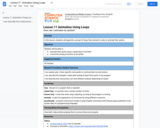
In this lesson, students will apply the concept of loops they learned in order to animate their sprites.
- Subject:
- Applied Science
- Computer Science
- Material Type:
- Activity/Lab
- Author:
- NYC Computer Science for All
- Date Added:
- 06/10/2021

In this lesson, students will apply the concept of loops they learned in order to animate their sprites.
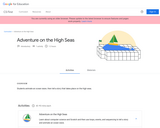
Students animate an ocean wave, then tell a story that takes place on the high seas.
Adventure on the High Seas is a one-hour activity designed to be completed within 45-75 minutes. Students will watch a series of videos and create one coding project with opportunities to personalize their work using “Add-Ons,” which are mini-coding challenges that build on top of the core project.
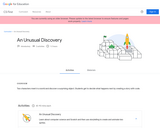
Two characters meet in a world and discover a surprising object. Students get to decide what happens next by creating a story with code.
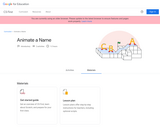
Students pick a name or word and bring the letters to life through animation, sound, and music.

Students bring the Google logo to life using code, utilizing programming and design.
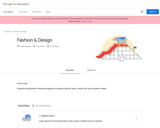
Students build fashion-themed programs including a fashion walk, a stylist tool, and a pattern maker.
Fashion & Design is a complete theme designed to be completed over eight, 45-75 minute sessions. For each Activity, students will watch a series of videos and create one coding project with opportunities to personalize their work using “Add-Ons,” which are mini-coding challenges that build on top of the core project.
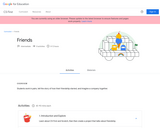
Students work in pairs, tell the story of how their friendship started, and imagine a company together.
Friends is a complete theme designed to be completed over eight, 45-75 minute sessions. For each Activity, students will watch a series of videos and create one coding project with opportunities to personalize their work using “Add-Ons,” which are mini-coding challenges that build on top of the core project.
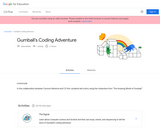
In this collaboration between Cartoon Network and CS First, students tell a story using the characters from “The Amazing World of Gumball.”
Gumball’s Coding Adventure is a one-hour activity designed to be completed within 45-75 minutes. Students will watch a series of videos and create one coding project with opportunities to personalize their work using “Add-Ons,” which are mini-coding challenges that build on top of the core project.
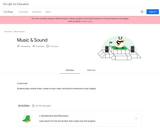
Students play musical notes, create a music video, and build an interactive music display.
Music & Sound is a complete theme designed to be completed over eight, 45-75 minute sessions. For each Activity, students will watch a series of videos and create one coding project with opportunities to personalize their work using “Add-Ons,” which are mini-coding challenges that build on top of the core project.
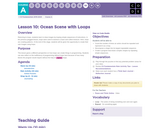
Returning to loops, students learn to draw images by looping simple sequences of instructions. In the previous plugged lesson, loops were used to traverse a maze and collect treasure. Here, loops are creating patterns. At the end of this stage, students will be given the opportunity to create their own images using loops.
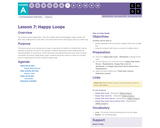
This activity revisits Happy Maps. This time, student will be solving bigger, longer puzzles with their code, leading them to see utility in structures that let them write longer code in an easier way.
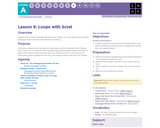
Building on the concept of repeating instructions from "Happy Loops," this stage will have students using loops to get to the acorn more efficiently on Code.org.
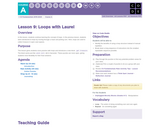
In this lesson, students continue learning the concept of loops. In the previous lesson, students were introduced to loops by moving through a maze and picking corn. Here, loops are used to collect treasure in open cave spaces.
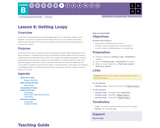
As we start to write longer and more interesting programs, our code often contains a lot of repetition. In this lesson, students will learn about how loops can be used to more easily communicate instructions that have a lot of repetition by looking at the repeated patterns of movement in a dance.
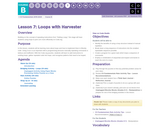
Building on the concept of repeating instructions from "Getting Loopy," this stage will have students using loops to pick corn more efficiently on Code.org.
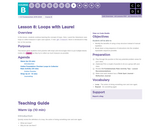
In this lesson, students continue learning the concept of loops. Here, Laurel the Adventurer uses loops to collect treasure in open cave spaces. A new `get treasure` block is introduced to help her on her journey.
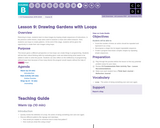
Returning to loops, students learn to draw images by looping simple sequences of instructions. In the previous online lesson, loops were used to traverse a maze and collect treasure. Here, students use loops to create patterns. At the end of this stage, students will be given the opportunity to create their own images using loops.

Building on the concept of repeating instructions from "Getting Loopy," this stage will have students using loops to help BB-8 traverse a maze more efficiently than before.
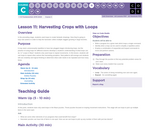
In the preceding stage, students used loops to create fantastic drawings. Now they're going to loop new actions in order to help the harvester collect multiple veggies growing in large bunches.
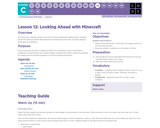
This lesson was originally created for the Hour of Code, alongside the Minecraft team. Students will get the chance to practice ideas that they have learned up to this point, as well as getting a sneak peek at conditionals!